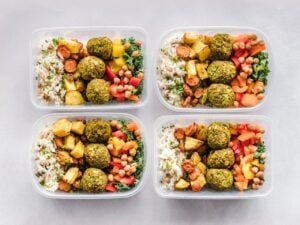Spring Fruits And Vegetables: Seasonal Produce Guide
The warm months are on their way, and you know what that means…We’re going to start craving the bright, crisp, mouth-watering spring fruits and vegetables. Seasonal eating is better for your health and the planet.
So, brighten up your daily routine with fresh, seasonal produce and easy meals from Gobble.
Your Spring Produce Guide
Seasonal fruits and vegetables are:
- Fresher and tastier than out-of-season produce
- Healthier
- More affordable
- Better for the planet
Out-of-season produce:
- Is often picked before it fully ripens due to long shipping times
- May lose nutrient density and flavor
- Carries a larger carbon footprint compared to local, seasonal alternatives
This is why it’s better to eat seasonal fruits in spring.
Wondering how to choose the best produce? Here are a couple of tips:
- Inspect for bright and vibrant colors: A lively hue generally means higher nutrient density. Avoid items with dull colors, soft spots, or bruises.
- Check firmness and texture: For fruits like avocados or kiwis, a gentle squeeze test goes a long way. Slight give under pressure indicates ripeness. For leafy greens, look for crisp leaves without wilting.
How to store your produce:
- Greens and herbs: Wrap loosely in a damp paper towel and store in a breathable bag or container in the crisper drawer.
- Root vegetables (carrots, turnips, radishes): Remove leafy tops, then refrigerate in a perforated bag to retain moisture.
- Citrus and tropical fruits: Keep them in the fridge for a longer shelf life, or leave at room temperature if you plan to use them soon.
Why shop local?
Opting for produce from local farmers’ markets or CSA programs not only supports your community but also reduces the carbon footprint of your meals. You’ll likely find just-picked fruits and vegetables with maximum flavor—plus, you’re encouraging small-scale farming practices that prioritize sustainability.
If you can’t make it to a local market, look for “locally grown” or “organic” labels at your grocery store to ensure you’re getting the freshest, most responsibly sourced goods.
When to buy:
We recommend buying seasonal fruits and vegetables year-round. You’ll ensure that you are eating a diverse, delicious, and sustainable menu.
We wrote this spring produce guide to help you pick the best seasonal fruits and vegetables. With our tips, you can make the most of this bountiful season!
After selecting your items, read a fresh produce storage guide to learn how to store your produce properly. That will ensure you make the most of your spring fruits and vegetables.
What Fruits Are In Season in Spring?
Wondering what fruits grow in the spring?
Seasonal spring fruits include classic favorites and surprising picks you may not expect. Here we list the major fruits, how to select fresh ingredients, what recipes you can use them in, and more!
Strawberries
One of the best spring fruits. There’s nothing more mouthwatering than a perfectly ripe spring strawberry!
Rich in vitamin C and potassium, strawberries support immune function and help reduce inflammation, according to WebMD. You can chop them and add them to a bowl of cereal. Alternatively, you can blend them into a refreshing smoothie.
Avocados
Finding that perfectly ripe avocado is a little bit easier in spring when these fruits are in season. To know if an avocado is ready to eat, lightly squeeze it in your hand.
The skin should be dark and firm, and the fruit should slightly give under gentle pressure. When you’re sure it’s ready, enjoy it spread on some toast or mashed into guacamole.
According to Healthline, avocados are high in healthy monounsaturated fats, fiber, and potassium. They promote heart health and aid in digestion.
Lemons and Limes
Excellent sources of Vitamin C—these are great for any seasonal shopper looking for spring fruits in season. Healthline states that these citrus fruits boost the immune system and enhance iron absorption.
Enjoy the refreshing taste of citrus…
- Sliced into a glass of water
- Zested over pasta
- Squeezed into juice
We recommend trying other types of citrus if you enjoy lemons and limes.
Pineapples
Thought pineapples are a summer fruit? Don’t let its tropical vibes fool you.
The peak season for pineapples actually begins in March! Medical News Today states that pineapples contain bromelain, an enzyme that aids digestion, along with vitamin C and manganese for antioxidant defense and bone health.
Enjoy this spring fruit…
- On its own
- In smoothies
- As a surprise ingredient in jerk stir-fry
- In a simmered curry
- Atop a classic pizza
Apricots
Apricots are an underrated spring fruit. They provide a great source of potassium and fiber.
If you’ve never shopped for apricots before, look for ones that are firm, plump, and don’t have any discolorations. They provide potassium and fiber, supporting heart health and digestion.
Enjoy them cooked with a bit of butter and cinnamon on top of oatmeal for breakfast. Another idea is to chop them into a spring salad with some seasonal spring greens.
Kiwis
Kiwis are spring fruits rich in nutrients like Vitamin C, Vitamin K, and dietary fiber, according to Health.com. A ripe kiwi will be slightly soft and give way under gentle pressure. To check, press near the stem with your thumb. If it’s too soft or the skin breaks easily, it’s overripe.
They are widely used in fruit salads, smoothies, and as a tangy topping for pavlovas and tarts. If you want to enjoy drinks using spring fruits in season, you can also prepare Kiwi Mojitos.
Grapefruit
Grapefruit, a beloved citrus fruit, reaches peak juiciness and flavor in spring. Look for ones that feel heavy for their size, indicating juiciness, and have smooth, firm skin.
Remember, the deeper the color, the more intense the flavor. According to Johns Hopkins Medicine, grapefruit is high in vitamin C and antioxidants, grapefruit supports immune function and may help improve cholesterol levels.
This versatile fruit is delightful and fresh, which adds a vibrant touch to salads. It can be broiled with a sprinkle of sugar for an easy dessert or juiced for a refreshing drink.
Cherries
Cherries usher in spring with their bright red color and juicy flavor. Choose ones with bright, glossy skin and firm texture, avoiding soft or wrinkled ones.
Rich in fiber, vitamin C, and anthocyanins, cherries may reduce inflammation and support sleep due to their natural melatonin content, according to NIH.
Enjoy them as snacks or in a cherry pie. They’re great in sauces for desserts or savory dishes. For a spring drink, muddle them in a cherry mojito or blend them into a smoothie.
Mangoes
Want to know what fruits are in season in spring but are also tropical? Mangoes add a tropical touch to spring with their sweet, creamy texture.
Medbox states that mangoes contain flavonoids that help maintain stable blood pressure, strengthen bones, and may reduce cancer risk.
Choose a slightly soft one with a fragrant aroma near the stem. Enjoy in smoothies, salsa, or just sliced. For a fast dessert, mix mango cubes with lime juice and chili powder for a sweet and spicy treat.
Mulberries
Mulberries are a sweet and tangy spring fruit. They’re available in white, red, and black varieties, each with a unique flavor.
Choose firm, plump berries with vibrant color and no blemishes. Eat them soon after purchase for the best taste.
According to Healthline, mulberries offer vitamins C and K, iron, and fiber, supporting immune health, blood clotting, oxygen transport, and digestion.
These spring berries are great in oatmeal, yogurt, sorbet, salads, and homemade vinaigrette. Enjoy their natural sweetness in various dishes this spring!
Other Seasonal Spring Fruits
There are so many fruits available to choose from in the spring! Some of the best spring fruits you can find this time of year include apples, bananas, and kumquats.
Spring Seasonal Vegetables
Getting your daily dose of veggies is fun and easy when you focus on buying seasonal produce. Below we list the best spring vegetables, how to select the right ones, and some recipes.
These spring vegetables are in their prime from March to May. They provide endless flavor opportunities.
Collard Greens, Kale, and Spinach
Collard greens, kale, and spinach all belong to a family of superfoods. They ripen just in time for the spring weather. These greens are high in vitamins A, C, and K, and also provide a good source of calcium and fiber, according to Healthline.
Replace your regular iceberg lettuce with these green giants. Watch as you pack in the nutrients! Enjoy in a salad or blended into a healthy and delicious green smoothie. The more seasonal fruits, the better!
Peas
Whether you prefer garden, snow, or snap—peas are a great spring vegetable to add some crunch to your meal. Throw them whole into a salad or stir fry for some flavor and texture diversity.
WebMD states that peas provide fiber, vitamins A, C, and K, and protein, supporting eye health, immune function, blood clotting, and muscle maintenance.
You can also enjoy pea greens in the spring as a farm-fresh garnish for pasta, sandwiches, and soups. Learn how to store fresh herbs to enjoy this vegetable to the fullest!
Carrots
What doesn’t go with carrots? This sweet spring vegetable mixes perfectly into a:
- Salad
- Stir fry
- Juice
- Smoothie
- Soup
You can even eat it raw as a snack with hummus or ranch dip.
Rich in beta-carotene (vitamin A), fiber, and antioxidants, carrots support vision, digestion, and may reduce cancer risk, according to Medical News Today.
Onions
Many varieties of onions begin becoming seasonally available in March. These include the aptly named spring onion. Spring onions make the perfect addition to nearly any dish. They’re one of the best spring vegetables.
Onions contain antioxidants and sulfur compounds that may reduce inflammation and support heart health, according to WebMD.
Artichokes
Many think of artichokes as a fall veggie. But they actually enjoy two crop harvests, including one in the spring!
Don’t be intimidated if you’ve never cooked with artichoke before. Despite their thorns, artichokes have a soft heart. They offer a deliciously nutty flavor that will keep you coming back for more.
Cleveland Clinic states that artichokes are high in fiber, vitamins C and K, and folate, artichokes support digestion, immune function, blood clotting, and cell growth.
Mushrooms
While technically not a vegetable, these edible fungi deserve an honorable mention.
Mushrooms are a great source of nutrients that aren’t available in most vegetables. Some examples are Vitamin D and selenium (which are important for immune health).
UCLA Health states that these vegetables also offer selenium and antioxidants, supporting immune health and protecting against cell damage.
Mushrooms can be enjoyed in a variety of dishes such as soups, stir-fries, pasta, or substitute meat.
Asparagus
Asparagus welcomes spring with its delicate flavor and vibrant green spears. It’s packed with vitamins A, C, and K, fiber, and folate, according to US News Health.
Choose firm, bright spears with perky tips, avoiding woody stems or limp tips. This versatile veggie shines in recipes. (Ex. roasted asparagus with olive oil, asparagus risotto, and more!)
Fiddlehead ferns
Fiddlehead ferns are young fern fronds coiled in spring. They’re a delicacy known for their unique flavor and texture. They’re packed with omega-3, omega-6 fatty acids, iron, and fiber, according to WebMD.
Choose tightly coiled, brightly colored fiddleheads without wilting. Enjoy them blanched, sautéed with garlic and butter, as a salad garnish, or in creamy pasta for a seasonal touch.
Fava beans
Fava beans are spring vegetables with rich flavors and numerous health benefits. High in protein and fiber, they’re a hearty addition to any diet, especially supporting digestive health, as cited by NIH.
Choose bright green, firm pods without brown spots for the best quality.
They work well in salads, stews, spring vegetable risotto, and more. We recommend learning about different types of salad greens to make the best combo. Enjoy their healthy and flavorful goodness!
Leeks
Leeks, known for their delicate, sweet flavor, are a great addition to spring dishes. Rich in vitamins A, C, and K, they offer heart and digestive health benefits, as stated by Healthline.
Choose leeks with firm stalks, green leaves, and white roots, avoiding wilted ones.
Versatile in the kitchen, they enhance soups, stir-fries, and quiches. You can also eat them as a charred side dish. Try a leek and potato soup or leek tart to savor their mild, rich taste.
Green Garlic
Green garlic is milder and more delicate than mature garlic. This springtime gem, rich in allicin, offers anti-inflammatory and antioxidant benefits, according to a Pharmalogolical Research study cited on ScienceDirect.
Look for firm stalks and a bright green hue for the freshest green garlic. It’s perfect for subtle flavoring pesto, stir-fries, and soups. Blend it into a green garlic aioli or add to salads for a fresh taste.
Other Spring Seasonal Vegetables
Spring is such a bountiful season. It’s hard to choose just a few veggies to enjoy! Some other vegetables to harvest in springtime include:
- Broccoli
- Celery
- Radishes
- Rhubarb
- Turnips
- Many herbs and spices
Delicious Seasonal Eating Made Easy with Spring Fruits and Vegetables
Ready to prep your spring produce? Here are a few tips to help you out:
- Gentle cooking methods: Steaming, sautéing, or lightly roasting helps lock in nutrients and maintain crisp textures. Avoid overcooking, which can diminish vitamins and taste.
- Season smartly: Use fresh herbs, citrus zest, and a drizzle of good-quality olive oil to enhance natural flavors without relying on heavy sauces.
- Experiment with raw prep: Many spring veggies—like peas, carrots, and radishes—taste fantastic raw. Shave, spiralize, or thinly slice them for salads and slaws.
- Preserve extra bounty: Make quick pickles or simple jams if you find yourself with more produce than you can eat right away. This way, you’ll enjoy that spring-fresh taste all season long.
A few recipes to get you started:
- Vegan-Friendly Roasted Asparagus & Mushrooms: Toss asparagus spears and sliced mushrooms with olive oil, salt, and pepper. Roast at 400°F for 15–20 minutes. Drizzle with lemon juice for a bright finish.
- Gluten-Free Spring Pea Soup: Sauté onions, green garlic, and peas in a small amount of butter or olive oil. Add vegetable broth and simmer until tender. Blend until creamy, then top with fresh pea shoots.
- Quick & Easy Stir-Fry: Combine snap peas, carrots, onions, and artichoke hearts in a wok with a simple sauce of soy sauce, ginger, and a dash of honey. Perfect for beginners seeking a flavorful, veggie-packed meal.
Spring is a busy season. Take control of your meals and keep eating healthy on a budget.
Enjoy spring fruits and veggies with Gobble! Here’s how it works:
We offer easy meal prep in 15 minutes or less with our diverse menu options. Our meals are thoughtfully sourced with health and sustainability in mind. By opting for our services, you will avoid food waste.
Our chef-crafted and prepared meals take the guesswork out of seasonal produce shopping.
Going lean this spring? Try our Lean & Clean plan for a personalized menu with lean protein, no grains, and a focus on healthy fats. Gobble is here to make meal choices easy and rewarding.
Our Classic Plan is also great—you’ll still enjoy thoughtfully sourced ingredients that taste fresh and flavorful.
For other seasonal produce beyond spring fruits and vegetables, check out:



